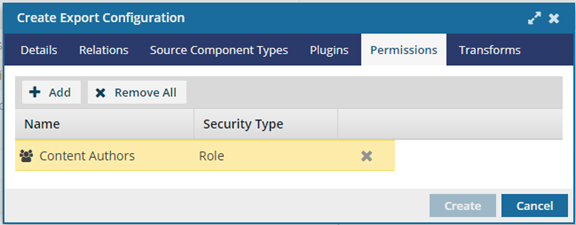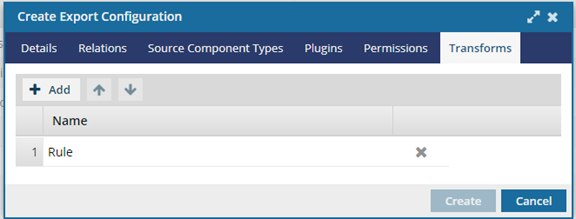You must have permission to be an administrator before you can work with export conditions. You can define what content you want to download from Inspire using export configurations. You'll need to specify the type of component in Source Components, and inside that component, which referenced content you want to export.
 Tips and Tricks
Tips and Tricks
 You must have administrator permissions to work with import configurations.
You must have administrator permissions to work with import configurations. - You must create your own XSLT that can transform the XML structure in the files you want to export.
- You must import your XSLT into Inspire to add it to an export configuration. Follow the steps in Import components.
- After you create an export configuration, you can I save it under a new name. Follow the steps in Save an export configuration with a new name.

 For more information:
For more information:


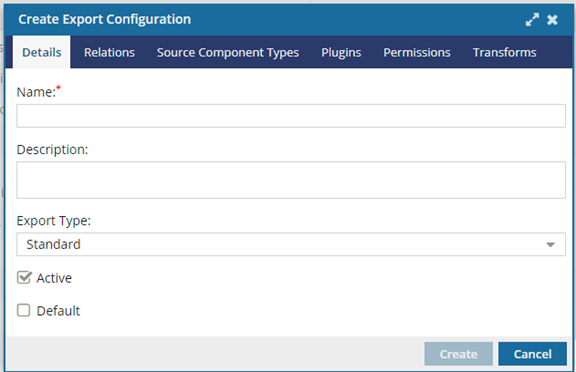

To create an export configuration:
-
From the
 Administration menu, select Export configuration.
Administration menu, select Export configuration.
-
On the Export configuration tab, click Create.
-
On the Details tab, in Name, enter a unique title for this export configuration in 50 characters or less.
-
On the Details tab, specify any optional information:
-
In Description, enter additional information for this export configuration in 1000 characters or less.
-
In Export Type, select Standard, Publish, Translation, or Compare Content.
If you don't choose an export type, Inspire assigns Standard to your export configuration.
-
If you don't want users to see this configuration when exporting, publishing, or translating components, clear the Active checkbox.
-
To use this export configuration automatically when users are exporting, publishing, or translating components, select the Default. Keep in mind that users can select another option besides the default.
Note: Inspire users who click
Publish automatically see this export configuration selected in the
Publish Configuration drop down box.
- If you don't select the Default option for any export configurations and only one export configuration is defined for that type, that one configuration is used.
- If you don't select the Default option for any export configurations and there are multiple export configurations for this Export Type, the first default configuration in the list is used.
- If you select the Default option for multiple export configurations for this Export Type, the first default configuration in the list is used.
- To see the list of export configurations, go to the
 Administration module and select Export Configuration.
Administration module and select Export Configuration.
-
Optionally, to add an element name and limit the export to only the specified element relationship:
-
On the Create Export Configuration dialog, select the Relations tab.
-
Click Add.
-
On the Add Relations dialog, select the checkbox next to one or more relation, and then click Add.
-
To limit the export configuration to a specific element relationship, in the relations row, click the Elements column, and use the drop down arrow
 to select the element name.
to select the element name.
Note: By default, the element name is empty and all relations apply to all element types defined within the relation.
-
Optionally, to limit the downloaded content to only the types you specify:
-
On the Create Export Configuration dialog, select the Source Component Types tab.
-
Click Add.
-
On the Add Source Component Types dialog, select the checkbox next to one or more source component types.
-
Click Add.
-
Optionally, to use a plug-in for formatting the output:
-
On the Create Export Configuration dialog, select the Plugins tab.
-
Click Add.
-
On the Available Plugins dialog, select the checkbox next to one or more plugin.
-
Click Add.
-
To change the order in which the plugins are used, in the toolbar, use the Up
 and Down
and Down  arrows.
arrows.
-
To save the plug-in information, click Create.
-
On the Export configuration tab, to re-open the export configuration you just created, double-click it.
-
On the Update Export Configuration screen, select the Plugins tab.
-
To set plugin parameters, click Settings
 and follow the steps in Configure plug-in parameters.
and follow the steps in Configure plug-in parameters.
-
Optionally, to limit which users and roles can select this export configuration:
-
On the Create Export Configuration dialog, select the Permissions tab.
-
Click Add.
-
On the Select Users/Roles dialog, select the checkbox next to one or more users and roles.
-
Click Select.
-
Optionally, to use an XSLT to transform output:
-
On the Create Export Configuration dialog, select the Transforms tab.
-
Click
 Add.
Add.
-
On the Select Components screen, in the Folders pane, locate the folder that contains the XSLT file.
-
In the Components pane, select the XSLT file and then click Select.
-
On the Create Export Configuration dialog, repeat steps b-d to add more XSLT files if necessary.
-
If you have multiple rows of stylesheets, you can set the order in which they are applied.
● To move an XSLT up in the order, click the up arrow

.
● To move an XSLT down in the order, click the down arrow

.
-
On the Create Export Configuration dialog, click Create.
On the Export Configuration tab, your export configuration is listed in the grid.
 Tips and Tricks
Tips and Tricks You must have administrator permissions to work with import configurations.
You must have administrator permissions to work with import configurations. 
 For more information:
For more information:




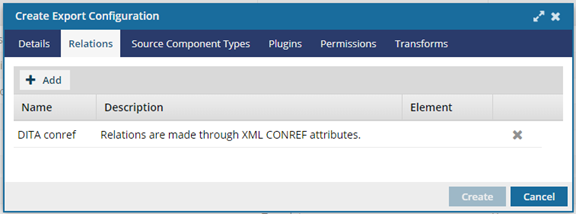
 to select the element name.
to select the element name.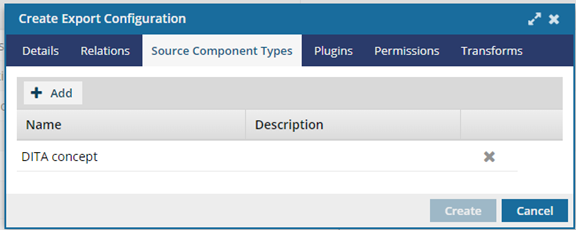
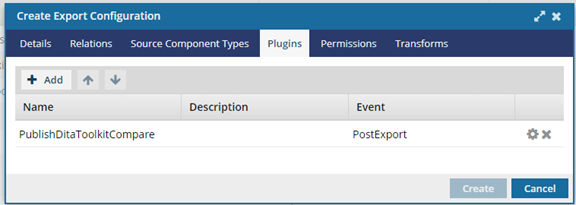
 and Down
and Down  arrows.
arrows.